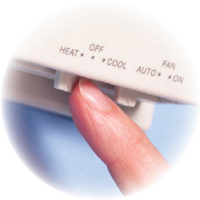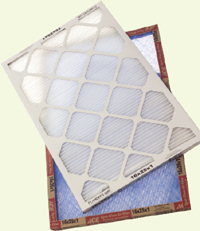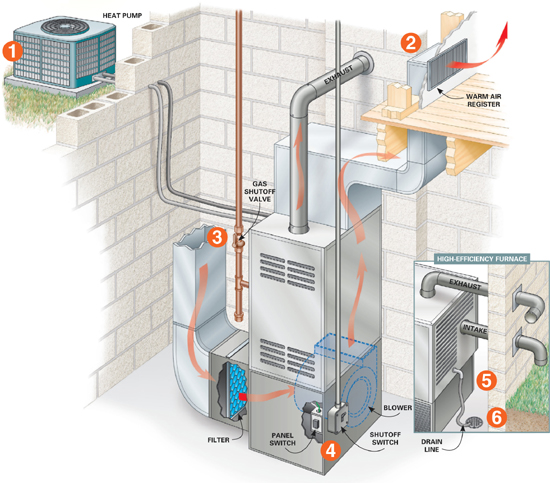No. 94
Fix your furnace
Check the basics before you call a pro—and save $100
When heating and cooling systems misbehave, pros always check the simplest things first. Most of these checks are things you can do yourself, even if you know zilch about your system. So do it! In a few minutes, you just might save yourself a hundred bucks or more.

Make sure the thermostat is on
Thermostats, especially programmable ones, can be complicated. The more options a thermostat has, the more that can go wrong.
• Make sure the switch is on the right setting (“heat” or “cool”).
• Check the temperature setting.
• Compare the temperature setting to the room temperature. Set the temperature five degrees higher than the room temperature and see if the furnace kicks on.
• Make sure the program is displaying the right day and time, as well as a.m. and p.m. settings.
• Replace the battery. If you have a power outage with a dead battery, you’ll lose your settings and the thermostat will revert to the default program.
• Open the thermostat and gently blow out any dust or debris. Make sure it’s level and firmly attached to the wall, and that none of the wires coming into it are loose.
The best thing you can do: Change filters regularly
Dirty filters are the most common cause of furnace problems. If the blower is running but no warm air (or cool in the summer) is coming out, replace the filter. A dirty filter also reduces the efficiency of the furnace and shortens its life. Check your owner’s manual to find out where the filter is located and how to remove it. Change inexpensive flat filters at least once a month. Make sure that the arrow points toward the furnace. Inspect pleated filters once a month. Hold them up to the light and if you can’t see the light clearly through them, replace them. Manufacturers say pleated filters are good for three months, but change them more frequently if you have pets, kids or generate lots of dust.

Lost your owner’s manual?
Most major-brand manuals are on the Web—just go to the manufacturer’s Web site.
HVAC message board
It’s hard to keep track of the furnace maintenance schedule. To make it easier, stick a small white magnetic board on your furnace duct. Write down the furnace filter size, brand, date the filter was last changed and when the furnace was last serviced. Update the information when you change the filter or have the furnace cleaned or checked.
Voice of experience
Over the phone, I always ask: Is the power on? The gas? Did you check the thermostat? And still—when I go to the home—I often find that one of these simple things was the problem.

Bob Schmahl, HVAC technician and The Family Handyman Field Editor

1. Check the heat pump
If you have a heat pump, clear away grass and leaves. If the fins on the outside of the unit are caked with dirt and debris, rinse them off.
2. Look for blocked registers
If your furnace comes on but one or two rooms are cold, make sure all the room registers are open and clear.
3. Make sure the gas is on
Just as with switches, someone may have turned off a gas valve and then forgotten to turn it back on. Trace the gas line back from the furnace to the meter, and if you see a handle that’s perpendicular to the gas pipe, turn it so it’s parallel. If you have an old furnace or boiler, you may have a pilot light. Remove the front panel and the burner cover and check to make sure it’s lit.
4. Check the shutoff switch and breaker
Furnace technicians often find that the only “repair” a furnace needs is to be turned on. Look for a standard wall switch on or near the furnace. Check the circuit breaker or fuse for the furnace as well. Make sure the front panel covering the blower motor is securely fastened—there’s a push-in switch under it that must be fully depressed for the furnace to operate.
5. Clear the intake and exhaust
Some furnaces exhaust through a pipe in the wall of the house rather than through a chimney. These furnaces also draw in air through a pipe. Make sure both pipes are clear, especially after heavy snow.
6. Flush the drain line
A drain tube plugged with sediment or mold will cause the furnace to shut down. To clean the line, remove it and fill it with a mix of bleach and water (25 percent bleach).
CAUTION! Always turn off the shutoff switch and turn the thermostat off or all the way down before changing the filter or working on the thermostat or furnace.



